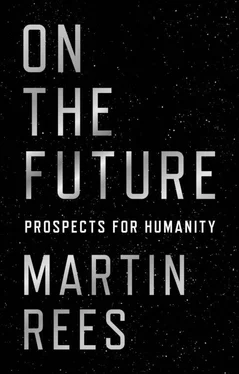A ‘dread factor’, and a feeling of helplessness, exaggerates public fear of radiation. As a consequence, all fission and fusion projects are impeded by disproportionate concern about even very low radiation levels.
The Japanese tsunami in 2011 claimed thirty thousand lives, mainly through drowning. It also destroyed the Fukushima Daiichi nuclear power stations, which were inadequately protected against a fifteen-metre-high wall of water, and suboptimally designed (for instance, the emergency generators were located low down, and were inactivated by flooding). Consequently, radioactive materials leaked and spread. The surrounding villages were evacuated in an uncoordinated way—initially just those within three kilometres of the power stations, then twenty kilometres, and then thirty—and with inadequate regard for the asymmetric way the wind was spreading the contamination. Some evacuees had to move three times. And some villages remain uninhabited, with devastating consequences for the lives of longtime residents. Indeed, the mental trauma, and other health problems such as diabetes, have proved more debilitating than the radiation risk. Many evacuees, especially the elderly ones, would be prepared to accept a substantially higher cancer risk in return for the freedom to live out their days in familiar surroundings. They should have that option. (Likewise, the mass evacuations after the Chernobyl disaster weren’t necessarily in the best interests of those who were displaced.)
Overstringent guidelines about the dangers of low-level radiation worsen the entire economics of nuclear power. After the decommissioning of the Dounreay experimental ‘fast breeder’ reactor in the north of Scotland, billions of pounds are being spent on an ‘interim cleanup’ between now and the 2030s, to be followed by further expense spread over several further decades. And nearly 100 billion pounds is budgeted, over the next century, to restore to “greenfields” the Sellafield nuclear installations in England. Another policy concern is this: were a city centre to be attacked by a ‘dirty bomb’ (a conventional chemical explosion laced with radioactive material), some evacuation would be needed. But, just as in Fukushima, present guidelines would lead to a response that was unduly drastic, both in the extent and the duration of the evacuation. The immediate aftermath of a nuclear incident is not the optimum time for a balanced debate. That is why this topic needs a new assessment now and wide dissemination of clear and appropriate guidelines.
* * *
What will actually happen on the climate front? My pessimistic guess is that political efforts to decarbonise energy production won’t gain traction, and that the CO 2concentration in the atmosphere will increase at an accelerating rate through the next twenty years, even if the Paris pledges are honoured. But by then we’ll know with far more confidence—from a longer time base of data, and from better modelling—just how strong the feedback from water vapour and clouds actually is. If the ‘climate sensitivity’ is low, we’ll relax. But if it’s high, and climate consequently seems on an irreversible trajectory into dangerous territory (tracking the steepest of the temperature rise scenarios in the fifth IPCC report), there may then be a pressure for ‘panic measures’. This could involve a ‘plan B’—being fatalistic about continuing dependence on fossil fuels but combating the effects of releasing CO 2into the atmosphere via a massive investment in carbon capture and storage at all fossil-fuel-powered power stations.
More controversially, the climate could be actively controlled by geoengineering. [20]The ‘greenhouse warming’ could be counteracted by (for instance) putting reflecting aerosols in the upper atmosphere, or even vast sunshades in space. It seems feasible to throw enough material into the stratosphere to change the world’s climate—indeed, what is scary is that this might be within the resources of a single nation, or perhaps even a single corporation. The political problems of such geoengineering may be overwhelming. There could be unintended side effects. Moreover, the warming would return with a vengeance if the countermeasures were ever discontinued, and other consequences of rising CO 2levels (especially the deleterious effects of ocean acidification) would be unchecked.
Geoengineering of this kind would be an utter political nightmare; not all nations would want to adjust the thermostat in the same way. Very elaborate climatic modelling would be needed in order to calculate the regional impacts of any artificial intervention. It would be a bonanza for lawyers if an individual or a nation could be blamed for bad weather! (Note, however, that a different kind of remedy—direct extraction of CO 2from the atmosphere—wouldn’t arouse disquiet. This doesn’t now seem economically feasible, but it is unobjectionable because it would merely be undoing the geoengineering that humans have already perpetrated through burning fossil fuels.)
Despite its unappealing features, geoengineering is worth exploring to clarify which options make sense and perhaps quench undue optimism about a technical ‘quick fix’ for our climate. It would also be wise to sort out the complex governance issues raised—and to ensure that these are clarified before climate change becomes so serious that there is pressure for urgent action.
As emphasised in the introduction, this is the first era in which humanity can affect our planet’s entire habitat: the climate, the biosphere, and the supply of natural resources. Changes are happening on a timescale of decades. This is far more rapid than the natural changes that occurred throughout the geological past; on the other hand, it is slow enough to give us, collectively or on a national basis, time to plan a response—to mitigate or adapt to a changing climate and modify lifestyles. Such adjustments are possible in principle—though a depressing theme threading though this book is the gap between what is technically desirable and what actually occurs.
We should be evangelists for new technologies—without them we’d lack much of what makes our lives better than the lives of earlier generations. Without technology the world can’t provide food, and sustainable energy, for an expanding and more demanding population. But we need it to be wisely directed. Renewable energy systems, medical advances, and high-tech food production (artificial meat, and so forth) are wise goals; geoengineering techniques probably are not. However, scientific and technical breakthroughs can happen so fast and unpredictably that we may not properly cope with them; it will be a challenge to harness their benefits while avoiding the downsides. The tensions between the promises and the hazards of new technology are the theme of the next chapters.
2
HUMANITY’S FUTURE ON EARTH
Robert Boyle is best remembered today for ‘Boyle’s law’, relating the pressure and density of gases. He was one of the ‘ingenious and curious gentlemen’ who, in 1660, founded the Royal Society of London, which still exists as the United Kingdom’s academy of sciences. These men (and there were no women among them) would have called themselves ‘natural philosophers’ (the term ‘scientist’ didn’t exist until the nineteenth century); in the words of Francis Bacon, whose writings deeply influenced them, they were ‘merchants of light’, pursuing enlightenment for its own sake; but they were also practical men engaged in the problems of their time, and aiming (to quote Bacon again) at ‘the relief of Man’s estate’.
Boyle was a polymath. After he died in 1691, a handwritten note was found among his papers, with a ‘wish list’ of inventions that would benefit humankind. [1]In the quaint idiom of his time, he envisaged some advances that have now been achieved, and some that still elude us more than three centuries later. Here is part of his list:
Читать дальше


![Мартин Рис - Всего шесть чисел. Главные силы, формирующие Вселенную [litres]](/books/414169/martin-ris-vsego-shest-chisel-glavnye-sily-formir-thumb.webp)









